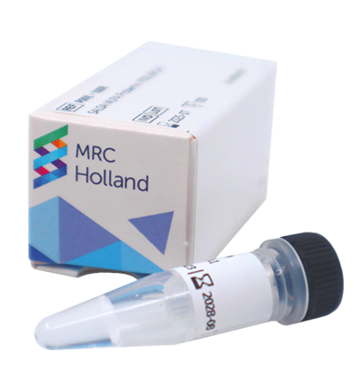The SALSA MLPA Probemix P107 Neurometabolic disorders is a research use only (RUO) assay for the detection of deletions or duplications in the D2HGDH, L2HGDH, MLYCD and MLC1 genes, which are associated with neurometabolic disorders.
The D2HGDH gene encodes D-2-hydroxyglutarate dehydrogenase, a mitochondrial enzyme belonging to the FAD-binding oxidoreductase/transferase type 4 family. This enzyme converts D-2-hydroxyglutarate to 2-ketoglutarate. Mutations in the D2HGDH gene are present in D-2-hydroxyglutaric aciduria, a rare recessive neurometabolic disorder causing developmental delay, epilepsy, hypotonia, and dysmorphic features.
The L2HGDH gene encodes L-2-hydroxyglutarate dehydrogenase, an FAD-dependent enzyme that oxidizes L-2-hydroxyglutarate to alpha-ketoglutarate in a variety of mammalian tissues. Mutations in this gene cause L-2-hydroxyglutaric aciduria, a rare autosomal recessive neurometabolic disorder resulting in moderate to severe intellectual disability.
Malonyl-CoA decarboxylase deficiency is a rare autosomal recessive (liver, brain, heart, and skeletal muscle) metabolic disorder characterized by malonic aciduria, developmental delay, seizures, hypoglycemia, acidosis, short stature and cardiomyopathy. The disorder is caused by mutations in the malonyl-CoA decarboxylase gene (MLYCD).
Megalencephalic leukoencephalopathy with subcortical cysts (MLC) is an inherited neurological disorder with macrocephaly before the age of one and slowly progressive deterioration of motor functions. Mutations in the MLC1 gene, encoding a putative membrane protein, have been identified as a cause for MLC.
The D2HGDH gene (10 exons), spans ~34 kb of genomic DNA and is located on 2q37.3, ~242 Mb from the p-telomere (close to the q-telomere). The L2HGDH gene (10 exons), spans ~70 kb of genomic DNA and is located on 14q22.1, ~50 Mb from the p-telomere. The MLYCD gene (5 exons), spans ~28 kb of genomic DNA and is located on 16q23.3, ~82 Mb from the p-telomere. The MLC1 gene (12 exons), spans ~26 kb of genomic DNA and is located on 22q13.33, ~49 Mb from the p-telomere.
More information is available at https://www.ncbi.nlm.nih.gov/books/NBK1535/.





